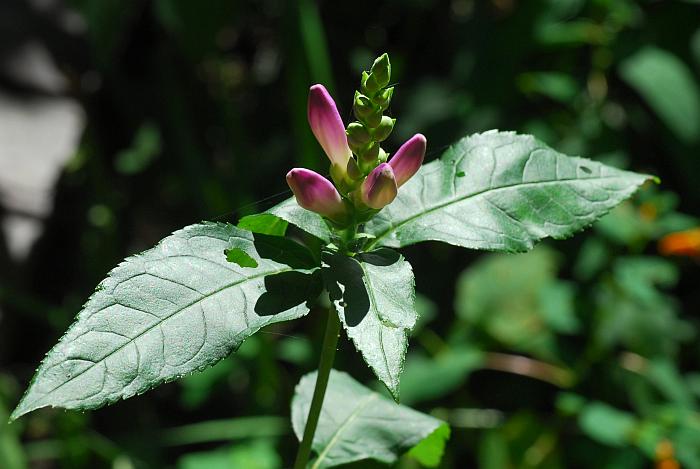Chelone obliqua L.
Rose Turtlehead

Native
CC = 10
CW = -5
MOC = 12
SRank = S2
© SRTurner
Chelone obliqua L.Rose Turtlehead | |
 |
Native CC = 10 CW = -5 MOC = 12 SRank = S2 |
© SRTurner |
|
Family - Plantaginaceae Habit - Rhizomatous perennial herb. Stems - Ascending to erect, to 1.5 m, sometimes sprawling with age, mostly unbranched, glabrous.
Leaves - Opposite, simple, petiolate, 4-20 cm long, 12-60 cm wide, lanceolate to elliptic, tips sharply pointed, margins sharply toothed with ascending teeth, glabrous.
Inflorescences - Dense terminal spikes to 9 cm long, usually subtended by a pair of bracts similar to the stem leaves. Flowers subtended by 2 or 3 sepaloid bractlets immediately beneath calyx, these ovate, pointed at tip, 4-10 mm long.
Flowers - Calyces 7-11 mm long, deeply 5-lobed, the lobe margins sometimes thin and translucent, minutely short-hairy. Corollas 28-37 mm long, bilabiate, 5-lobed but often appearing more or less 4-lobed, glabrous externally, the tube longer than the lobes, pink to reddish purple, sometimes lighter toward the tip or base, the lower lip shallowly 3-lobed and bearded with woolly hairs, the upper lip slightly to moderately keeled and arched downward or slightly helmet-shaped, minutely notched to shallowly 2- lobed at the tip. Fertile stamens 4 with anther sacs densely wooly. Staminode 1, white, glabrous. Style 1, not exserted, the stigma capitate, unlobed.
Fruits - Capsules, broadly ovoid to nearly globose, with minute beaked tip, glabrous, with 2 locules. Seeds numerous, 3-4 mm, roundish and strongly flattened, brown. Flowering - August - October. Habitat - Bottomland forests, sloughs, fens, streambanks. Origin - Native to the U.S. Lookalikes - Physostegia virginiana, also the pink form of Chelone glabra. Other info. - This plant is often cultivated but rarely seen in the wild. In Missouri it occurs in widely scattered locations, mostly on the eastern side of the state. Its U.S. distribution is in the eastern half of the country but is sparse, with every state except Illinois listing it as rare. In fact, both species of Chelone are listed as species of conservation concern in Missouri, C. obliqua with an S2 (imperiled) ranking. The plant is easy to recognize, although it could be confused with Physostegia virginiana, a far more common species which has squarish stems, narrower leaves, and usually more flowers in the inflorescence. For C. obliqua, look for ovate, glossy deep green leaves and distinctively shaped flowers in a tight cluster. Photographs taken at Shaw Nature Reserve, Franklin County, MO, 10-3-2011 and 9-12-2018 (SRTurner). |